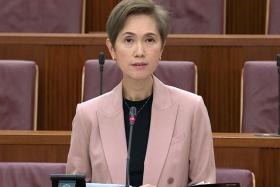New school canteen models to tackle stallholder shortages
As more stallholders retire and filling vacant canteen stalls may become more challenging in future, the Education Ministry (MOE) is in discussions with schools on new ways to run their canteens.
Acknowledging the difficulties of some schools in finding stallholders, Education Minister Chan Chun Sing said on Nov 12 in Parliament that his ministry is discussing with schools that are keen and ready to adopt a different operating model.
For instance, meals can be pre-ordered and prepared at a central kitchen before they are delivered to schools, he said, adding that this model has been piloted at Yusof Ishak Secondary School and shown to be effective.
“Where there are existing stallholders impacted by such a transition, schools will help by referring them to nearby schools or recommending them for employment by the central kitchen operator,” he said.
Mr Chan was responding to questions from several MPs Louis Chua (Sengkang GRC), He Ting Ru (Sengkang GRC) and Yip Hon Weng (Yio Chu Kang) on school canteen stalls.
Mr Chua asked about the possibility of providing direct subsidies to school canteen vendors to offset rising costs of healthier ingredients and complying with nutritional guidelines, while Ms He raised questions about meeting the nutritional needs of children from lower socio-economic backgrounds during school hours.
In April 2024, The Straits Times reported that schools in Singapore, including Yusof Ishak Secondary School, have been exploring alternatives as they face difficulties in finding suitable canteen stall vendors, or are looking to improve students’ dietary habits.
Yusof Ishak Secondary School and Blangah Rise Primary School did away with manned stalls and turned to catered food from airline catering and logistics company Sats, while Spectra Secondary School caters from Select Group.
An MOE spokesman said then that most schools currently have an “adequate” number of stalls to meet the needs of students. But from time to time, some schools may struggle to find stallholders, for example when the vendors retire.
There were 65 advertisements from primary and secondary schools listed on the MOE website for stallholders as at Nov 12.
The ministry will continue to explore options, said Mr Chan, which include the central kitchen delivery model and vending machines, as well as the conventional option of having stall operators.
Responding to Ms He, who asked if vending machines can provide nutritious meals for students including those from lower-income backgrounds, Mr Chan said they would be used mainly for snacks and drinks, and are just one option for schools.
This would help free up the manpower in the canteen to provide hot meals for students, said Mr Chan.
“So, we will use all models to provide various options for the different schools according to their different needs,” Mr Chan said, adding that MOE works with schools to monitor the quality, quantity and price of food.
Canteen stallholders are required to serve meals that follow the Health Promotion Board’s guidelines, covering the four main food groups to ensure the nutritional needs of students are met, he said.
Stall rentals – which range from $5 to $15 a month – are waived during school holidays for stallholders, and the ministry regularly reviews food pricing guidelines to help stallholders keep their costs sustainable, Mr Chan said.
He added that students from lower-income families receive school meal subsidies, and schools are also given additional funds to provide more help for students in need.
Get The New Paper on your phone with the free TNP app. Download from the Apple App Store or Google Play Store now

